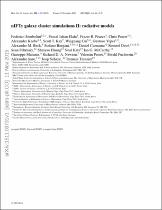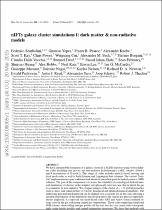JavaScript is disabled for your browser. Some features of this site may not work without it.
- ResearchSpace
- →
- Research Publications/Outputs
- →
- Journal Articles
- →
- View Item
| dc.contributor.author |
Sembolini, F

|
|
| dc.contributor.author |
Elahi, PJ

|
|
| dc.contributor.author |
Pearce, FR

|
|
| dc.contributor.author |
Power, C

|
|
| dc.contributor.author |
Knebe, A

|
|
| dc.contributor.author |
February, Sean

|
|
| dc.date.accessioned | 2017-05-17T07:21:04Z | |
| dc.date.available | 2017-05-17T07:21:04Z | |
| dc.date.issued | 2016-04 | |
| dc.identifier.citation | Sembolini, F., Elahi, P.J., Pearce, F.R. et al. 2016. nIFTy galaxy cluster simulations II: radiative models. Monthly Notices of the Royal Astronomical Society, 459(3): 2973-2991. DOI: https://doi.org/10.1093/mnras/stw800 | en_US |
| dc.identifier.issn | 0035-8711 | |
| dc.identifier.uri | https://academic.oup.com/mnras/article-abstract/459/3/2973/2595204/nIFTy-galaxy-cluster-simulations-II-Radiative?redirectedFrom=fulltext | |
| dc.identifier.uri | DOI: https://doi.org/10.1093/mnras/stw800 | |
| dc.identifier.uri | http://hdl.handle.net/10204/9092 | |
| dc.description | © 2016 The Authors | en_US |
| dc.description.abstract | We have simulated the formation of a massive galaxy cluster (M(supcrit)(sub200) = 1.1×10(sup15)h(sup-1)M) in a CDM universe using 10 different codes (RAMSES, 2 incarnations of AREPO and 7 of GADGET), modeling hydrodynamics with full radiative subgrid physics. These codes include Smoothed-Particle Hydrodynamics (SPH), spanning traditional and advanced SPH schemes, adaptive mesh and moving mesh codes. Our goal is to study the consistency between simulated clusters modeled with different radiative physical implementations - such as cooling, star formation and AGN feedback. We compare images of the cluster at z=0, global properties such as mass, and radial profiles of various dynamical and thermodynamical quantities. We find that, with respect to non-radiative simulations, dark matter is more centrally concentrated, the extent not simply depending on the presence/absence of AGN feedback. The scatter in global quantities is substantially higher than for non-radiative runs. Intriguingly, adding radiative physics seems to have washed away the marked code-based differences present in the entropy profile seen for non-radiative simulations in Sembolini et al. (2015): radiative physics + classic SPH can produce entropy cores. Furthermore, the inclusion/absence of AGN feedback is not the dividing line -as in the case of describing the stellar content- for whether a code produces an unrealistic temperature inversion and a falling central entropy profile. However, AGN feedback does strongly affect the overall stellar distribution, limiting the effect of overcooling and reducing sensibly the stellar fraction. | en_US |
| dc.language.iso | en | en_US |
| dc.publisher | Oxford University Press on behalf of the Royal Astronomical Society | en_US |
| dc.relation.ispartofseries | Worklist;16643 | |
| dc.subject | Galaxies: clusters: general | en_US |
| dc.subject | Galaxies: haloes | en_US |
| dc.subject | Galaxies: evolution | en_US |
| dc.subject | Cosmology: theory | en_US |
| dc.subject | Galaxies: formation | en_US |
| dc.title | nIFTy galaxy cluster simulations II: radiative models | en_US |
| dc.type | Article | en_US |
| dc.identifier.apacitation | Sembolini, F., Elahi, P., Pearce, F., Power, C., Knebe, A., & February, S. (2016). nIFTy galaxy cluster simulations II: radiative models. http://hdl.handle.net/10204/9092 | en_ZA |
| dc.identifier.chicagocitation | Sembolini, F, PJ Elahi, FR Pearce, C Power, A Knebe, and Sean February "nIFTy galaxy cluster simulations II: radiative models." (2016) http://hdl.handle.net/10204/9092 | en_ZA |
| dc.identifier.vancouvercitation | Sembolini F, Elahi P, Pearce F, Power C, Knebe A, February S. nIFTy galaxy cluster simulations II: radiative models. 2016; http://hdl.handle.net/10204/9092. | en_ZA |
| dc.identifier.ris | TY - Article AU - Sembolini, F AU - Elahi, PJ AU - Pearce, FR AU - Power, C AU - Knebe, A AU - February, Sean AB - We have simulated the formation of a massive galaxy cluster (M(supcrit)(sub200) = 1.1×10(sup15)h(sup-1)M) in a CDM universe using 10 different codes (RAMSES, 2 incarnations of AREPO and 7 of GADGET), modeling hydrodynamics with full radiative subgrid physics. These codes include Smoothed-Particle Hydrodynamics (SPH), spanning traditional and advanced SPH schemes, adaptive mesh and moving mesh codes. Our goal is to study the consistency between simulated clusters modeled with different radiative physical implementations - such as cooling, star formation and AGN feedback. We compare images of the cluster at z=0, global properties such as mass, and radial profiles of various dynamical and thermodynamical quantities. We find that, with respect to non-radiative simulations, dark matter is more centrally concentrated, the extent not simply depending on the presence/absence of AGN feedback. The scatter in global quantities is substantially higher than for non-radiative runs. Intriguingly, adding radiative physics seems to have washed away the marked code-based differences present in the entropy profile seen for non-radiative simulations in Sembolini et al. (2015): radiative physics + classic SPH can produce entropy cores. Furthermore, the inclusion/absence of AGN feedback is not the dividing line -as in the case of describing the stellar content- for whether a code produces an unrealistic temperature inversion and a falling central entropy profile. However, AGN feedback does strongly affect the overall stellar distribution, limiting the effect of overcooling and reducing sensibly the stellar fraction. DA - 2016-04 DB - ResearchSpace DP - CSIR KW - Galaxies: clusters: general KW - Galaxies: haloes KW - Galaxies: evolution KW - Cosmology: theory KW - Galaxies: formation LK - https://researchspace.csir.co.za PY - 2016 SM - 0035-8711 T1 - nIFTy galaxy cluster simulations II: radiative models TI - nIFTy galaxy cluster simulations II: radiative models UR - http://hdl.handle.net/10204/9092 ER - | en_ZA |









